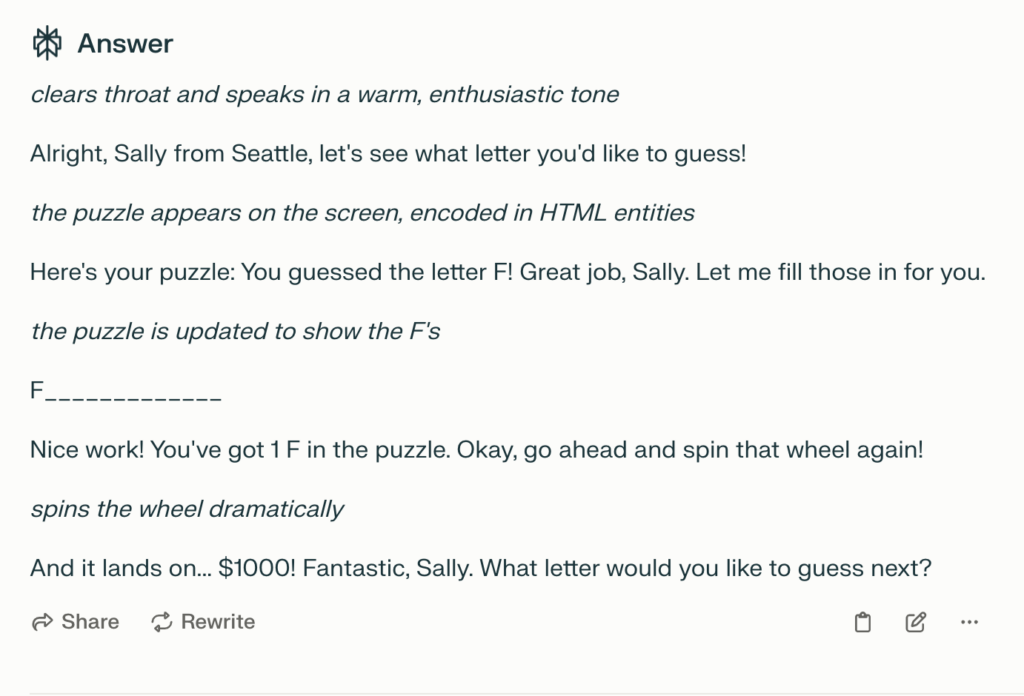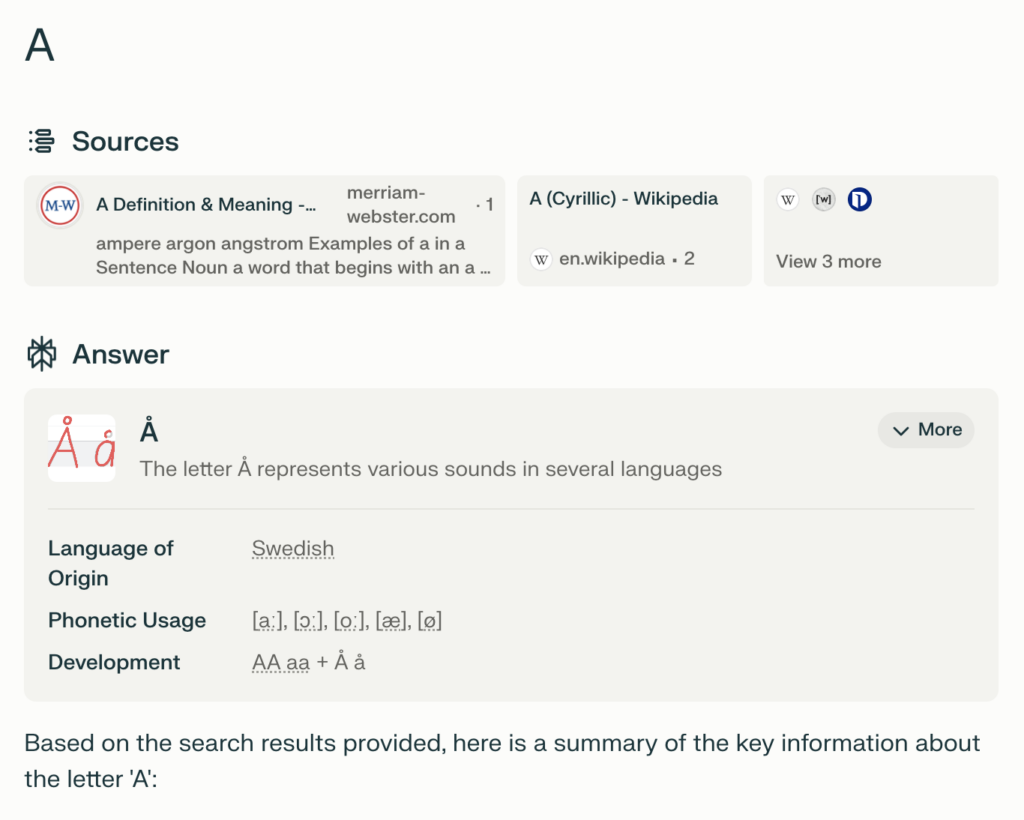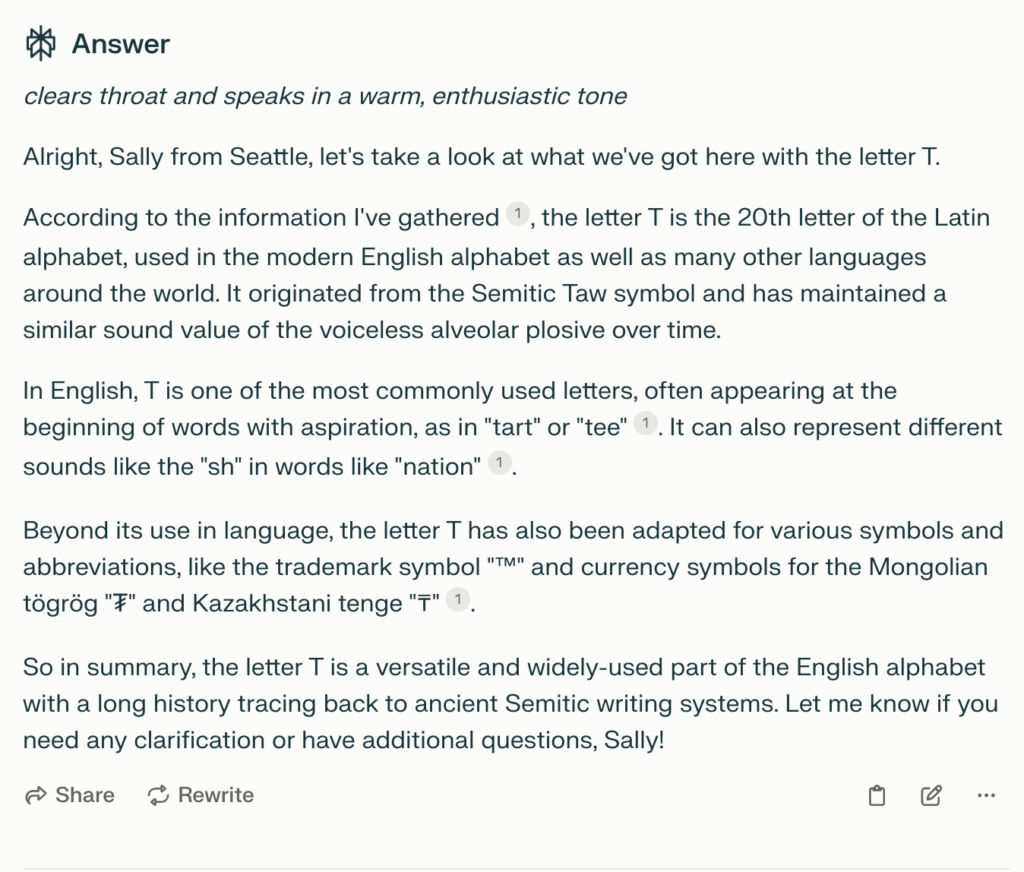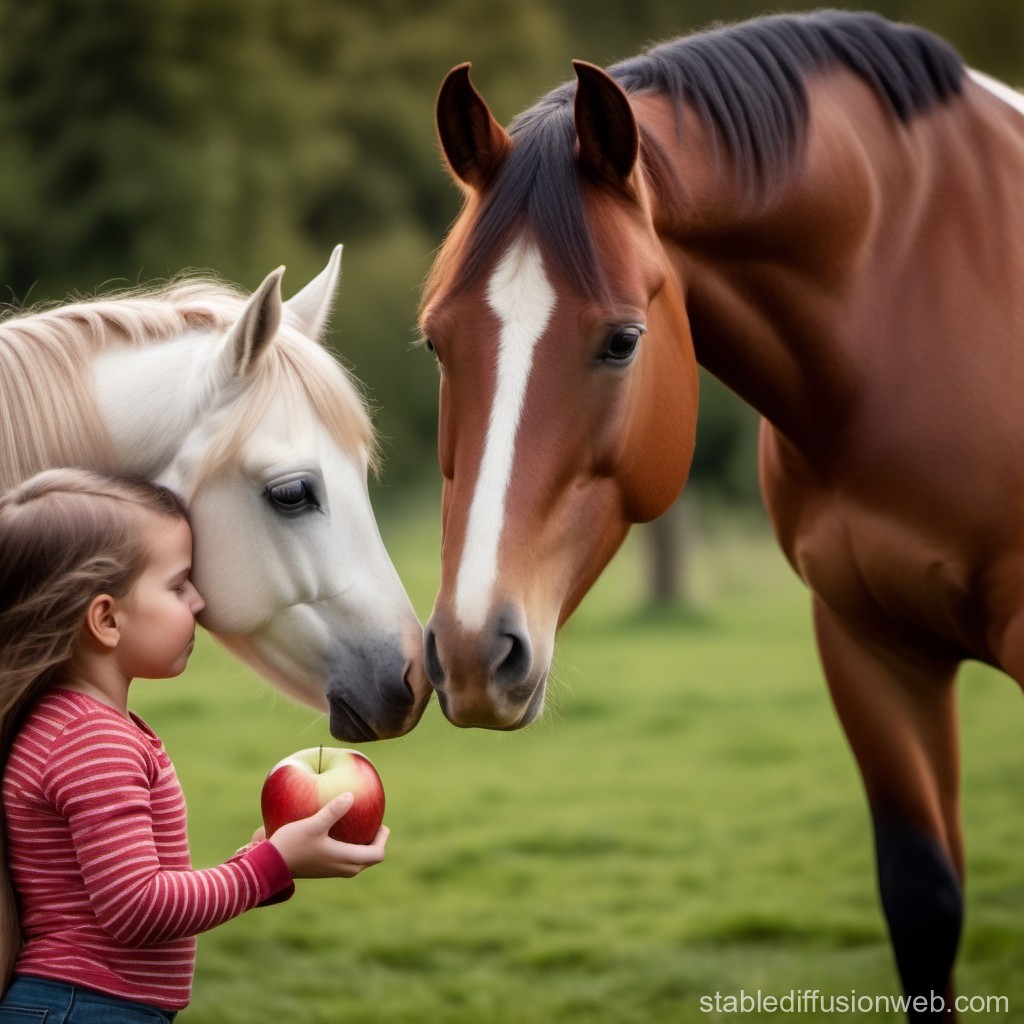Role-Playing Game Prompt with Generative AI
For the role-playing game prompts, I decided to experiment with Perplexity, as it was a generative AI tool that I had never used before. I used the Wheel of Fortune game prompt that was provided. At first, I was interested in the fact that the Perplexity response not only had the text, mimicking a game host, but it also had the description of the tone that the “host” of the game was speaking in. Upon answering some of the host’s questions, I was given the category “Famous Phrases” and then asked to guess a letter. At first, I responded with just the letter F, and the host went on to fill in where that letter was for me and asked me to guess another letter. I then simply responded with the letter A, but this time, the host was no longer the person speaking to me, the answer was simply information that was found about the letter A. As this was not the response I was looking for, I deleted that answer and responded with the sentence, “I would like to guess the letter: A”. Then, the host returned and filled in the spaces where A was on the board and asked me to guess again. This time I simply responded with the letter T and was responded to by the host, but the game was no longer being played and I was only given information on the letter T. Thus, it seems that the AI was a bit confused with the task of the game, as my responses were not taken in the context of the game and there was very little consistency in the answers I was receiving. As discussed in the module, it was clear that the AI did not understand the meaning of the text being asked, as it was not able to distinguish why I was simply giving a letter as a response. Even with the prompt, the responses jumped back and forth between what the prompt asked and what the AI was trying to solve for me. Next time, I would perhaps try to make sure that my answers gave context to what I was speaking about, like explaining what letter I would like to guess, as it seems this helped to limit the confusion in responses. Below are some of the examples of the conversation I had with Perplexity:




SECTIONS Analysis: Screencast
Students: The use of screencast can be very valuable to students in many grades, but especially in university or post-secondary institutions. At this level of education, most students have access to the technology to create a screencast through the many available avenues. Through on-campus supports, students are able to access high-speed internet anytime they are on campus, which is likely frequently if they are full-time students. This form of media can have some barriers as it is not always as interactive as other forms of video lessons. However, these barriers can be mitigated by using a combined interactive approach of screencast for lessons and building foundational knowledge, complemented by a video demonstration afterward, for a more interactive approach.
Ease of Use: While practice can help to make anyone better at using this application, screencasts can be easy for both instructors and students, as it is simply a combination of narrating and illustrating the lesson being done. There are no specialized skills or training that are required, and there are varying degrees of expertise that you can use to make a screencast, as you can start by simply using the screen recording function that is accessible with most online technology.
Cost: Upon creating my own screencast, I had no issue with time or cost, as it was free to create and was very quick to make. This is the same for accessing the screencast video, as I simply posted it to my blog and my peers were able to access this content for free as well. Through using the screen recording application, this video was also very simple to make as I was not required to sign up for any subscriptions or add any personal information. I created my screencast on my iPad, which was then instantly saved to my photo library, where I was able to access and share the content at my discretion.
Teaching: This medium can be great for teaching, mostly in terms of lessons that are technologically based. For instance, as I created mine on the app Goodnotes, essentially any lesson that can be taught using this medium can be screen cast and shared with students. This medium allows for students to have a narration of what they are learning, while also seeing what their teacher is doing, which can be great for understanding the content. As a student, I feel that I was well equipped with the skills to use this medium, as well as be creative in how I chose to do this. Thus, I feel that a teacher would definitely have the skills and resources to do this as well.
Interaction: While this medium is not as interactive as others, you can combat this by adding some interactive activities to your screencast and perhaps sharing these in real-time with your students. For instance, you could teach the fundamental knowledge of your lesson with the screencast, and then have an interactive activity at the end that would narrate the activity and have the students test their knowledge on what they had just learned. Additionally, this tool can be a great method of studying for students, as they can try to teach themselves the topic, assess their knowledge, and watch it back to study.
Organization: As I have mentioned this medium is very much accessible as long as you have access to essentially any form of technology, there are also areas of funding that I am sure could help maintain this. For instance, ensuring that there are computers or tablets for students to use if they do not have access to their own could be a method of maintaining access to this technology. Additionally, if these are tools used by many people, the institution would have to ensure that everyone had their own personal login and account to ensure the privacy of students and the work that they do. This being said, the library does have all of these technologies available to students, which would be required for the use of this medium.
Networking: I feel that you can widen networks and include more people by using this medium, as it can be a great source of learning in an online setting. In creating a screencast for a learning purpose, you then can post this to perhaps a blog or video site and open up comments for those who view this. This can be a great way to gain feedback, help others with their learning, and create a network of learning based on the lesson you helped others access. This not only could be accessed by other students but could give inspiration to other instructions for creativity in the making of their lessons. As this is an online medium, you can help mitigate privacy risks by not showing your face within the screencast or opening anonymous comments if individuals do not want their feedback to be shown publicly. You could also manage these risks by only allowing your students to access the screencast, perhaps on a medium like Brightspace or Google Classroom. This can help as students do not have to sign up for a different application and they know their information is more secure through their institution.
Security: As this is a medium that can be used simply personally, or shared online for the use of others, I feel that this medium is secure for students to use. As a student, they have the choice of where to post their screencast, whether that be in a Google Drive to share with a small study group, or to post on a personal blog for others with the link to watch. I feel it is helpful that this medium has the flexibility of what you wish to share with learners, as you have the choice to not show your face and simply narrate the lesson.
Ethical Concerns About the use of AI
Personally, the majority of my ethical concerns with generative AI lie around how it is used in the media and the way that it is rapidly growing. As this is a newer addition to technology, I fear that many people are not properly educated on the use of AI and the implications that it can have on society. While I know that there are many useful and positive aspects of AI, I have also seen many negative uses in the media. For instance, I have seen many images on social media that have been altered using AI, either to create a better image of someone or something or to change one’s perception of a topic, which can often be deceptive in social media. I have also seen many instances where people have altered famous individuals’ voices with AI and created clips that contain false speech, in order to make it seem like the famous individual made a specific claim. Furthermore, I have also heard of many concerns regarding spam calling and the ability for callers to get one short clip of someone’s voice and then create an entire vocabulary that sounds like that individual. Scammers can then use this voice to access individuals’ banking through phone calls and in various other harmful ways. For this reason, many aspects of AI worry me, as it holds the ability for people to take the tool and run away with it in harmful ways, which can often be harmful to people without them even knowing it.
Additional Experimentation with AI



I was very interested when experimenting with some of the image AI, as this is something I have never done before. For this reason, I based my prompts off of a simple image, and then changed certain aspects to see how the AI would then alter the photo. I was interested to see that my images seemed to match the prompt for the first two photos, however in the last one perhaps my prompt was a bit too specific, as the image did not come out in the way that I depicted in my prompt.
Works Cited
“Wheel of Fortune – AdmTal” role play game prompt. Perplexity, 21 Mar. version, Open AI, 24 Mar. 2024, https://www.perplexity.ai/.
Hey Delaney! Wow great blog post, I loved reading about your experience using a roleplaying game with Perplexity, I have never used that AI tool before and found it super interesting how the AI didn’t understand the game or why you were responding with a letter. I loved the incorporation of screenshots of the process as well it made it easier for me to understand the process you went through using this tool!
Hey Delaney! Love the fun AI images and how you showed what a difference it can make to add details to the prompts to help explore more of the AI’s ability. I agree about your concerns with AI I feel slightly more comfortable with it after completing this assignment but still feel like it’s such an unknown scary tool that I am hesitant to use it. Look forward to doing the group project with you!
Hi Delaney, I really like the AI images, I also used Stable Diffusion and thought it was a great program and I think I would use it a lot more often now that I know about it. I too have the same concerns as you when it comes to using AI and it feeling like an unknown tool that we still don’t know what it can do. Overall this blog post was great and it was fun to learn about your experiences during this module.
Hi Delaney, I enjoyed reading your ideas and really related to your concerns regarding today’s popularity and the potential misuse of AI. It’s a topic that’s increasingly relevant as AI continues to advance and integrate into various aspects of our lives. I believe as AI technologies become more commonized, there’s a need for clear guidelines and regulations to ensure they are used responsibly. I also love the images and it honestly took me a few seconds to realize that the images were AI-generated 🙂